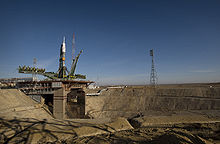Flame deflector

A flame deflector, flame diverter or flame trench is a structure or device designed to redirect or disperse the flame, heat, and
Design and operation
The diverter typically comprises a robust, heat-resistant structure that channels the force of the exhaust gases and flames in a specific direction, typically away from the rocket or equipment. This is essential to prevent the potentially destructive effects of the high-temperature gases and to reduce the acoustic impact of the ignition.
A flame trench can also be used in combination with a diverter to form a trench-deflector system. The flames from the rocket travel through openings in the launchpad onto a flame deflector situated in the flame trench, which runs underneath the launch structure and extends well beyond the launchpad itself.[3] To further reduce the acoustic effects a water sound suppression system may be also used.
Notable examples
Apollo program
During the Apollo program the need for a flame deflector was a determining factor in the design of the Kennedy Space Center Launch Complex 39. NASA designers chose a two-way, wedge-type metal flame deflector. It measured 13 meters in height and 15 meters in width, with a total weight of 317 tons. Since the water table was close to the surface of the ground, the designers wanted the bottom of the flame trench at ground level. The flame deflector and trench determined the height and width of the octagonal shaped launch pad.[2]
Space Shuttle program

During the
Baikonur Cosmodrome

The main launch pads at the Russian launch complex of Baikonur Cosmodrome use a flame pit to manage launch exhaust. The launch vehicles are transported by rail to the launch pad, where they are vertically erected over a large flame deflector pit.[7] A similar structure was built by the European Space Agency at its Guiana Space Centre.[7]
SpaceX Starship launch mount
During the
References
- ^ Herridge, Linda (2018-05-29). "Launch Pad 39B Flame Trench Nears Completion". NASA. Archived from the original on 2023-02-06. Retrieved 2023-09-01.
- ^ a b "Moonport, CH11-7". www.hq.nasa.gov. Archived from the original on 2023-09-01. Retrieved 2023-09-01.
- ^ a b c d Wessels, Wessel (2022-10-26). "The Purpose Of A Flame Trench At A Rocket Launch Site". Headed For Space. Archived from the original on 2023-09-01. Retrieved 2023-09-01.
- ^ a b "Deflecting the flames of a monster rocket". The Planetary Society. Archived from the original on 2023-09-01. Retrieved 2023-09-01.
- ^ Warnock, Lynda. "NASA - Flame Trench-Deflector System". www.nasa.gov. Archived from the original on 2022-11-28. Retrieved 2023-09-01.
- ^ Bergin, Chris (2016-05-08). "Renewing the famous Flame Trench, one brick at a time". NASASpaceFlight.com. Archived from the original on 2023-09-01. Retrieved 2023-09-01.
- ^ a b "Launcher". www.esa.int. Archived from the original on 2023-09-02. Retrieved 2023-09-02.
- ^ a b c "SpaceX Tests Starship Water Deluge System That It Should've Built in the First Place". Gizmodo. 2023-07-18. Archived from the original on 2023-09-01. Retrieved 2023-09-01.
- ^ Kolodny, Lora (2023-07-28). "SpaceX hasn't obtained environmental permits for 'flame deflector' system it's testing in Texas". CNBC. Archived from the original on 2023-10-07. Retrieved 2023-09-01.
- from the original on 2023-11-20. Retrieved 2023-11-20.
